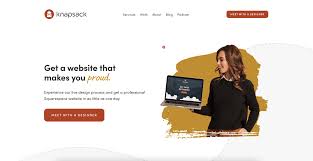
The Art of Web Page Design: Creating Stunning and Effective Websites
When it comes to creating a successful online presence, web page design plays a crucial role in capturing the attention of visitors and keeping them engaged. A well-designed website not only looks visually appealing but also functions smoothly and effectively. In this article, we will explore some key principles of web page design that can help you create stunning and user-friendly websites.
User Experience (UX) Design
One of the fundamental aspects of web page design is user experience (UX) design. UX design focuses on creating websites that are easy to navigate, intuitive to use, and provide a seamless experience for visitors. This includes factors such as clear navigation menus, responsive design for mobile devices, fast loading times, and accessible content.
Visual Hierarchy
Visual hierarchy is the arrangement of elements on a web page in order of importance. By using visual cues such as size, color, contrast, and spacing, designers can guide users’ attention to key elements such as call-to-action buttons, important information, or featured products. A well-defined visual hierarchy helps users quickly understand the content and purpose of the website.
Typography
The choice of typography can greatly impact the overall look and feel of a website. Selecting appropriate fonts that are easy to read and complement the design aesthetic is essential for creating a cohesive visual identity. Typography also plays a role in establishing hierarchy and emphasizing key messages on the web page.
Color Scheme
The color scheme used in web page design can evoke emotions, convey brand identity, and create visual interest. Careful selection of colors that harmonize with each other can enhance the overall appeal of the website while ensuring readability and accessibility for all users. Consistent use of colors across different elements helps create a unified look and feel.
Responsive Design
In today’s digital landscape, it is essential for websites to be responsive across various devices and screen sizes. Responsive design ensures that your website adapts seamlessly to different resolutions, providing an optimal viewing experience for users on desktops, laptops, tablets, and smartphones. This approach not only improves user engagement but also boosts search engine rankings.
By incorporating these key principles into your web page design process, you can create websites that are visually appealing, functional, and user-friendly. Remember that effective web page design is not just about aesthetics but also about delivering a positive user experience that keeps visitors coming back for more.
Top FAQs on Achieving the Best Web Page Design
- What is the best way to design a Web page?
- What is the ideal web design?
- Which is the best site for website design?
- Which web designing is best?
What is the best way to design a Web page?
When considering the best way to design a web page, it is essential to focus on creating a user-centric experience that is visually appealing, easy to navigate, and functional across different devices. Incorporating principles of user experience (UX) design, such as intuitive navigation, clear visual hierarchy, and responsive layout, can help ensure that visitors have a positive interaction with the website. Paying attention to typography, color scheme, and overall aesthetics can also contribute to creating a cohesive and engaging web page design. By prioritizing user needs and preferences while implementing best practices in web design, you can create a successful web page that effectively communicates your message and achieves your goals.
What is the ideal web design?
The ideal web design is one that strikes a perfect balance between aesthetics and functionality, creating a visually appealing and user-friendly experience for visitors. It should be responsive, ensuring seamless navigation across different devices, and prioritize user experience with intuitive layouts and clear calls to action. The ideal web design also considers factors such as loading speed, accessibility, and visual hierarchy to effectively convey information and engage users. Ultimately, the ideal web design is one that aligns with the brand identity, meets the needs of the target audience, and drives desired outcomes for the website owner.
Which is the best site for website design?
When seeking the best site for website design, it is important to consider various factors such as your specific needs, budget, and design preferences. There are several reputable platforms and services available that cater to different skill levels and requirements. Popular options include WordPress with its versatile themes and plugins, Squarespace for its user-friendly drag-and-drop interface, Wix for its customizable templates, and Shopify for e-commerce-focused designs. Ultimately, the best site for website design will depend on your individual goals and the level of customization and control you desire over your website’s appearance and functionality. It is recommended to explore different platforms, read reviews, and consider your unique requirements before making a decision.
Which web designing is best?
When it comes to determining the best web designing approach, it ultimately depends on the specific needs and goals of the website being developed. Different web design methods, such as responsive design, adaptive design, or custom design, offer unique advantages based on factors like user experience, functionality, and visual appeal. It is important to consider aspects like target audience, budget constraints, and desired features when choosing the most suitable web designing approach. By carefully evaluating these factors and working with experienced designers, you can select the best web designing method that aligns with your project requirements and objectives.
